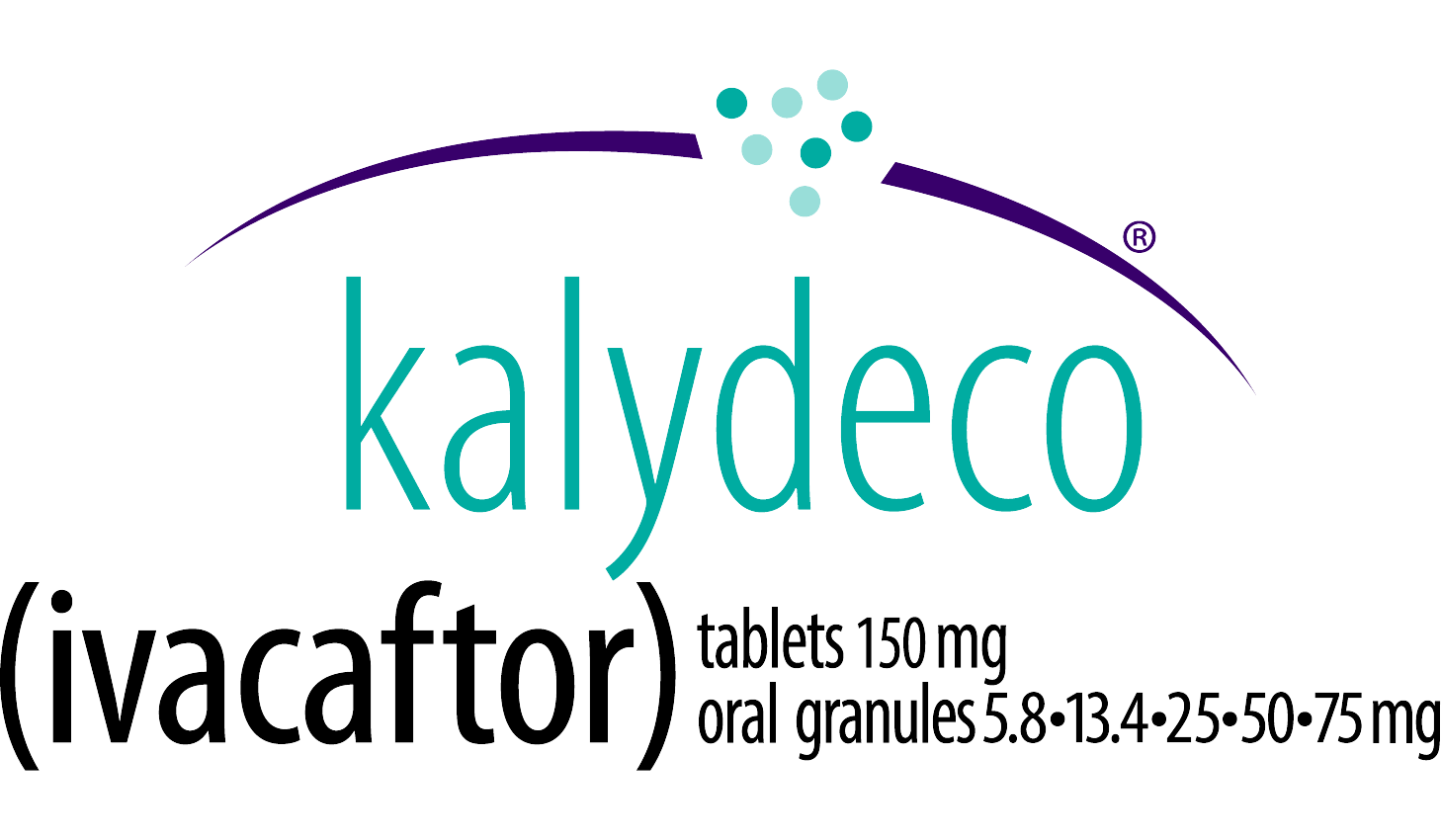Drug Interactions with KALYDECO® (ivacaftor)
Drug-Drug interaction profiles1
KALYDECO is supplied as tablets (150 mg) for patients 6 years and older and as oral granules (5.8 mg, 13.4 mg, 25 mg, 50 mg, and 75 mg packets) for patients aged 1 month to <6 years.
Concomitant use of strong or moderate CYP3A inhibitors is not recommended for patients age 1 to <6 months.1
| Metabolic types | Generic name Common brand name(s) | Potential effect on drug exposure | KALYDECO dosing and administration | Recommendations |
|---|---|---|---|---|
CYP3A substrate2 |
Alprazolam XANAX® |
Increased exposure of alprazolam |
One dose every 12 hours |
Caution and monitoring for benzodiazepine -related side effects |
Strong CYP3A inducer |
Carbamazepine TEGRETOL®, |
Decreased KALYDECO exposure |
Co-administration with KALYDECO is not recommended |
|
- |
Ciprofloxacina CIPRO® |
No effect on KALYDECO |
One dose every 12 hours |
No dose adjustment |
Strong CYP3A inhibitor |
Clarithromycin BIAXIN® |
Increased KALYDECO exposure |
One dose twice a week |
Dose adjustment |
CYP2D6 substrate3 |
Desipraminea NORPRAMIN® |
No effect on desipramine |
One dose every 12 hours |
No dose adjustment |
CYP3A substrate2 |
Diazepam VALIUM® |
Increased exposure of diazepam |
One dose every 12 hours |
Caution and monitoring for benzodiazepine -related side effects |
P-gp substrate |
Digoxinb LANOXIN® |
Increased exposure of digoxinb |
One dose every 12 hours |
Caution and appropriate monitoring for digoxin |
Moderate CYP3A inhibitor |
Erythromycin ERYC®, |
Increased KALYDECO exposure |
One dose once daily |
Dose adjustment |
Moderate CYP3A inhibitor |
Fluconazolea,c DIFLUCAN® |
Increased KALYDECO exposurec |
One dose once daily |
Dose adjustment |
Strong CYP3A inhibitor |
Itraconazole SPORANOX® |
Increased KALYDECO exposure |
One dose twice a week |
Dose adjustment |
Strong CYP3A inhibitor |
Ketoconazolea,d |
Increased KALYDECO exposured |
One dose twice a week |
Dose adjustment |
CYP3A substrate |
Midazolama,e |
Increased exposure of midazolame |
One dose every 12 hours |
Caution and monitoring for benzodiazepine -related side effects |
CYP3A substrate2,4 |
Oral |
No effect on oral contraceptive or KALYDECO |
One dose every 12 hours |
No dose adjustment |
Strong CYP3A inducer |
Phenobarbital |
Decreased KALYDECO exposure |
Co-administration with KALYDECO is not recommended |
|
Strong CYP3A inducer |
Phenytoin DILANTIN® |
Decreased KALYDECO exposure |
Co-administration with KALYDECO is not recommended |
|
Strong CYP3A inhibitor |
Posaconazole NOXAFIL® |
Increased KALYDECO exposure |
One dose twice a week |
Dose adjustment |
Strong CYP3A inhibitor |
Rifabutin MYCOBUTIN® |
Decreased KALYDECO exposure |
Co-administration with KALYDECO is not recommended |
|
Strong CYP3A inducer |
Rifampina,f RIFADIN® |
Decreased KALYDECO exposuref |
Co-administration with KALYDECO is not recommended |
|
CYP2C8 substrate2 |
Rosiglitazonea AVANDIA® |
No effect on rosiglitazone |
One dose every 12 hours |
No dose adjustment |
Strong CYP3A inducer |
St. John's wort |
Decreased KALYDECO exposure |
Co-administration with KALYDECO is not recommended |
|
CYP3A substrate |
Tacrolimus PROGRAF® |
Increased exposure of tacrolimus |
One dose every 12 hours |
Caution and appropriate monitoring for tacrolimus |
Strong CYP3A inhibitor |
Telithromycin |
Increased KALYDECO exposure |
One dose twice a week |
Dose adjustment |
CYP3A substrate2 |
Triazolam HALCION® |
Increased exposure of triazolam |
One dose every 12 hours |
Caution and monitoring for benzodiazepine -related side effects |
Strong CYP3A inhibitor |
Voriconazole VFEND® |
Increased KALYDECO exposure |
One dose twice a week |
Dose adjustment |
CYP2C9 substrate2 |
Warfarin JANTOVEN® |
Increased exposure of warfarin |
One dose every 12 hours |
Caution and monitoring of INR is recommended |
This is a representative list of drugs and common brand names and is not intended to be exhaustive.
Dose=one tablet or one packet of oral granules.
aThese interactions have been studied.
bCo-administration with digoxin increased digoxin exposure by 1.3-fold.
cCo-administration with fluconazole increased KALYDECO exposure (AUC) by 3-fold.
dCo-administration with ketoconazole significantly increased KALYDECO exposure (AUC) by 8.5-fold.
eKALYDECO increased midazolam exposure by 1.5-fold.
fCo-administration with rifampin significantly decreased KALYDECO exposure (AUC) by approximately 9-fold.
AUC, area under the curve; INR, international normalized ratio.
Potential drug interactions with KALYDECO
Inhibitors of CYP3A1
- Ivacaftor is a sensitive CYP3A substrate. Co-administration with ketoconazole, a strong CYP3A inhibitor, significantly increased ivacaftor exposure [measured as area under the curve (AUC)] by 8.5-fold. Based on simulations of these results, a reduction of the KALYDECO dose is recommended when co-administered with strong CYP3A inhibitors, such as ketoconazole, itraconazole, posaconazole, voriconazole, telithromycin, and clarithromycin
- Co-administration with fluconazole, a moderate inhibitor of CYP3A, increased ivacaftor exposure by 3-fold. Therefore, a reduction of the KALYDECO dose is recommended for patients taking concomitant moderate CYP3A inhibitors, such as fluconazole and erythromycin
- Co-administration of KALYDECO with grapefruit juice, which contains one or more components that moderately inhibit CYP3A, may increase exposure of ivacaftor. Therefore, food or drink containing grapefruit should be avoided during treatment with KALYDECO
Inducers of CYP3A1
Co-administration with rifampin, a strong CYP3A inducer, significantly decreased ivacaftor exposure (AUC) by approximately 9-fold. Therefore, co-administration with strong CYP3A inducers, such as rifampin, rifabutin, phenobarbital, carbamazepine, phenytoin, and St. John’s wort is not recommended.
Ciprofloxacin1
Co-administration of KALYDECO with ciprofloxacin had no effect on the exposure of ivacaftor. Therefore, no dose adjustment is necessary during concomitant administration of KALYDECO with ciprofloxacin.
Potential for KALYDECO to affect other drugs1
CYP2C9 Substrates
Ivacaftor may inhibit CYP2C9; therefore, monitoring of the international normalized ratio (INR) during co-administration of KALYDECO with warfarin is recommended. Other therapeutic products for which exposure may be increased by KALYDECO include glimepiride and glipizide; these therapeutic products should be used with caution.
CYP3A and/or P-gp substrates1
Ivacaftor and its M1 metabolite have the potential to inhibit CYP3A and P-gp. Co-administration with oral midazolam, a sensitive CYP3A substrate, increased midazolam exposure 1.5 fold, consistent with weak inhibition of CYP3A by ivacaftor. Co-administration with digoxin, a sensitive P-gp substrate, increased digoxin exposure by 1.3 fold, consistent with weak inhibition of P-gp by ivacaftor. Administration of KALYDECO may increase systemic exposure of drugs that are substrates of CYP3A and/or P-gp, which may increase or prolong their therapeutic effect and adverse events. Therefore, caution and appropriate monitoring are recommended when co administering KALYDECO with sensitive CYP3A and/or P-gp substrates, such as digoxin, cyclosporine, and tacrolimus.
IMPORTANT SAFETY INFORMATION
WARNINGS AND PRECAUTIONS
Transaminase (ALT or AST) Elevations
- Elevated transaminases have been reported in patients with CF receiving KALYDECO. Transaminase elevations were more common in patients with a history of transaminase elevations or in patients who had abnormal transaminases at baseline. ALT and AST should be assessed prior to initiating KALYDECO, every 3 months during the first year of treatment, and annually thereafter. For patients with a history of transaminase elevations, consider more frequent monitoring of liver function tests
- Patients who develop increased transaminase levels should be closely monitored until the abnormalities resolve. Dosing should be interrupted in patients with ALT or AST of greater than 5 times the upper limit of normal (ULN). Following resolution of transaminase elevations, consider the benefits and risks of resuming KALYDECO
INDICATIONS AND USAGE
KALYDECO is indicated for the treatment of cystic fibrosis (CF) in patients age 1 month and older who have at least one mutation in the CFTR gene that is responsive to ivacaftor potentiation based on clinical and/or in vitro assay data.
If the patient's genotype is unknown, an FDA-cleared CF mutation test should be used to detect the presence of a CFTR mutation followed by verification with bi-directional sequencing when recommended by the mutation test instructions for use.
INDICATIONS AND USAGE
KALYDECO is indicated for the treatment of cystic fibrosis (CF) in patients age 1 month and older who have at least one mutation in the CFTR gene that is responsive to ivacaftor potentiation based on clinical and/or in vitro assay data.
If the patient's genotype is unknown, an FDA-cleared CF mutation test should be used to detect the presence of a CFTR mutation followed by verification with bi-directional sequencing when recommended by the mutation test instructions for use.
IMPORTANT SAFETY INFORMATION
WARNINGS AND PRECAUTIONS
Transaminase (ALT or AST) Elevations
- Elevated transaminases have been reported in patients with CF receiving KALYDECO. Transaminase elevations were more common in patients with a history of transaminase elevations or in patients who had abnormal transaminases at baseline. ALT and AST should be assessed prior to initiating KALYDECO, every 3 months during the first year of treatment, and annually thereafter. For patients with a history of transaminase elevations, consider more frequent monitoring of liver function tests
- Patients who develop increased transaminase levels should be closely monitored until the abnormalities resolve. Dosing should be interrupted in patients with ALT or AST of greater than 5 times the upper limit of normal (ULN). Following resolution of transaminase elevations, consider the benefits and risks of resuming KALYDECO
Hypersensitivity Reactions, Including Anaphylaxis
- Hypersensitivity reactions, including cases of anaphylaxis, have been reported in the postmarketing setting. If signs or symptoms of serious hypersensitivity reactions develop during treatment, discontinue KALYDECO and institute appropriate therapy. Consider the benefits and risks for the individual patient to determine whether to resume treatment with KALYDECO
Concomitant Use With CYP3A Inducers
- Use of KALYDECO with strong CYP3A inducers, such as rifampin, substantially decreases the exposure of ivacaftor, which may reduce the therapeutic effectiveness of KALYDECO. Co-administration of KALYDECO with strong CYP3A inducers, such as rifampin, rifabutin, phenobarbital, carbamazepine, phenytoin, and St. John's wort is not recommended
Cataracts
- Cases of non-congenital lens opacities/cataracts have been reported in pediatric patients treated with KALYDECO. Baseline and follow-up ophthalmological examinations are recommended in pediatric patients initiating treatment with KALYDECO
ADVERSE REACTIONS
Serious Adverse Reactions
- Serious adverse reactions, whether considered drug-related or not by the investigators, which occurred more frequently in patients treated with KALYDECO included abdominal pain, increased hepatic enzymes, and hypoglycemia
Most Common Adverse Reactions
- The most common adverse reactions in the 221 patients treated with KALYDECO were headache (17%), upper respiratory tract infection (16%), nasal congestion (16%), nausea (10%), rash (10%), rhinitis (6%), dizziness (5%), arthralgia (5%), and bacteria in sputum (5%)
- The safety profile for the CF patients enrolled in clinical trials (Trials 3-8) was similar to that observed in the 48-week, placebo-controlled trials (Trials 1 and 2)
USE IN SPECIFIC POPULATIONS
Pediatric Use
- The safety and effectiveness of KALYDECO in patients with CF younger than 1 month of age have not been established. The use of KALYDECO in children under the age of 1 month is not recommended
- Use of KALYDECO in patients aged 1 to less than 6 months born at a gestational age less than 37 weeks has not been evaluated
Click here to access full Prescribing Information.
References:
1. KALYDECO [prescribing information]. Boston, MA: Vertex Pharmaceuticals Incorporated; August 2023. 2. Data on File. Vertex Pharmaceuticals Incorporated. Boston, MA. REF-10745; 2021. 3. Norpramin [prescribing information]. Bridgewater, NJ: Sanofi-Aventis Incorporated; 2012. 4. Belle DJ, Callaghan JT, Gorski JC, et al. The effects of an oral contraceptive containing ethinyl estradiol and norgestrel on CYP3A activity. J Clin Pharmacol. 2002;53:67-74.

